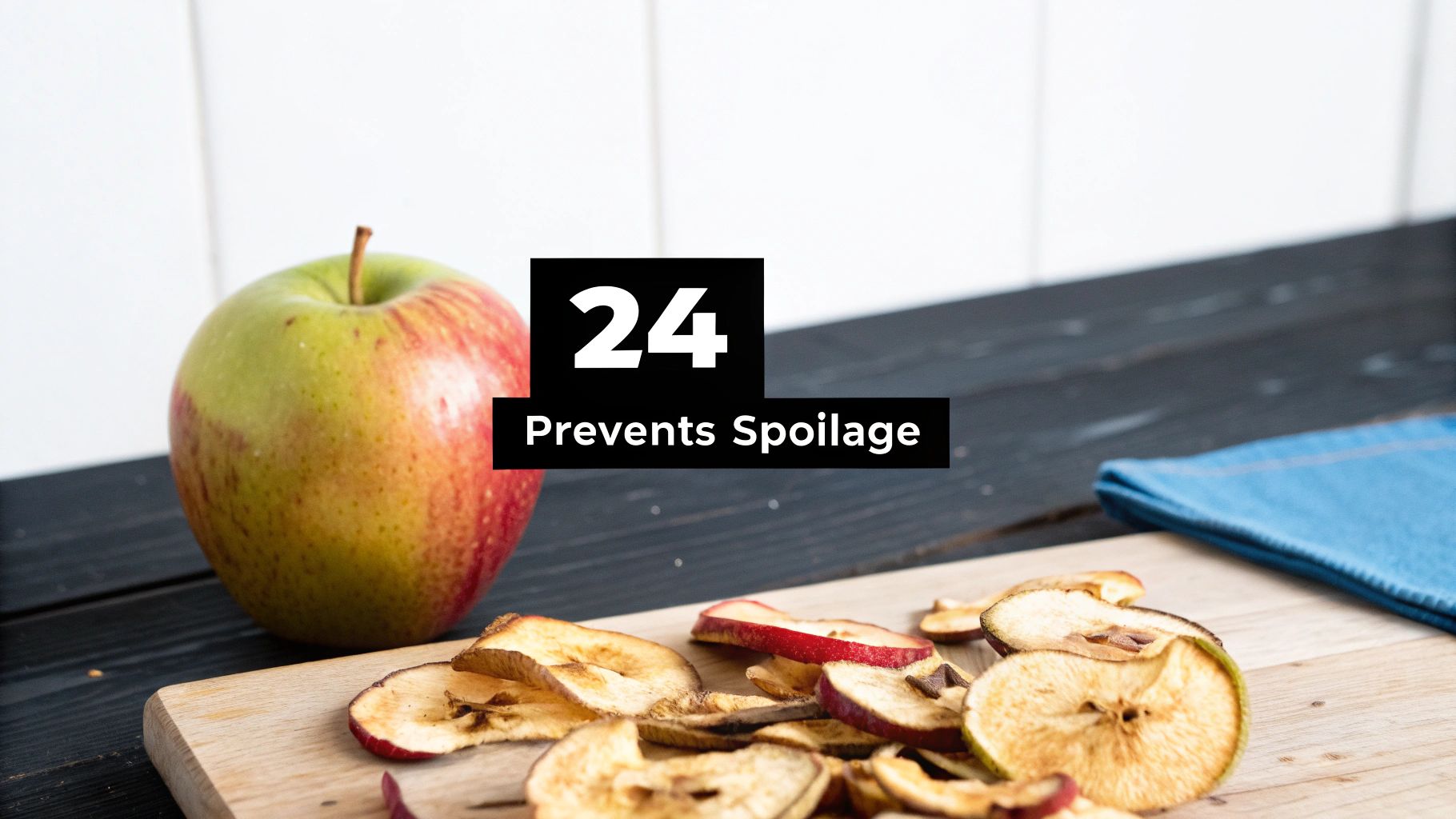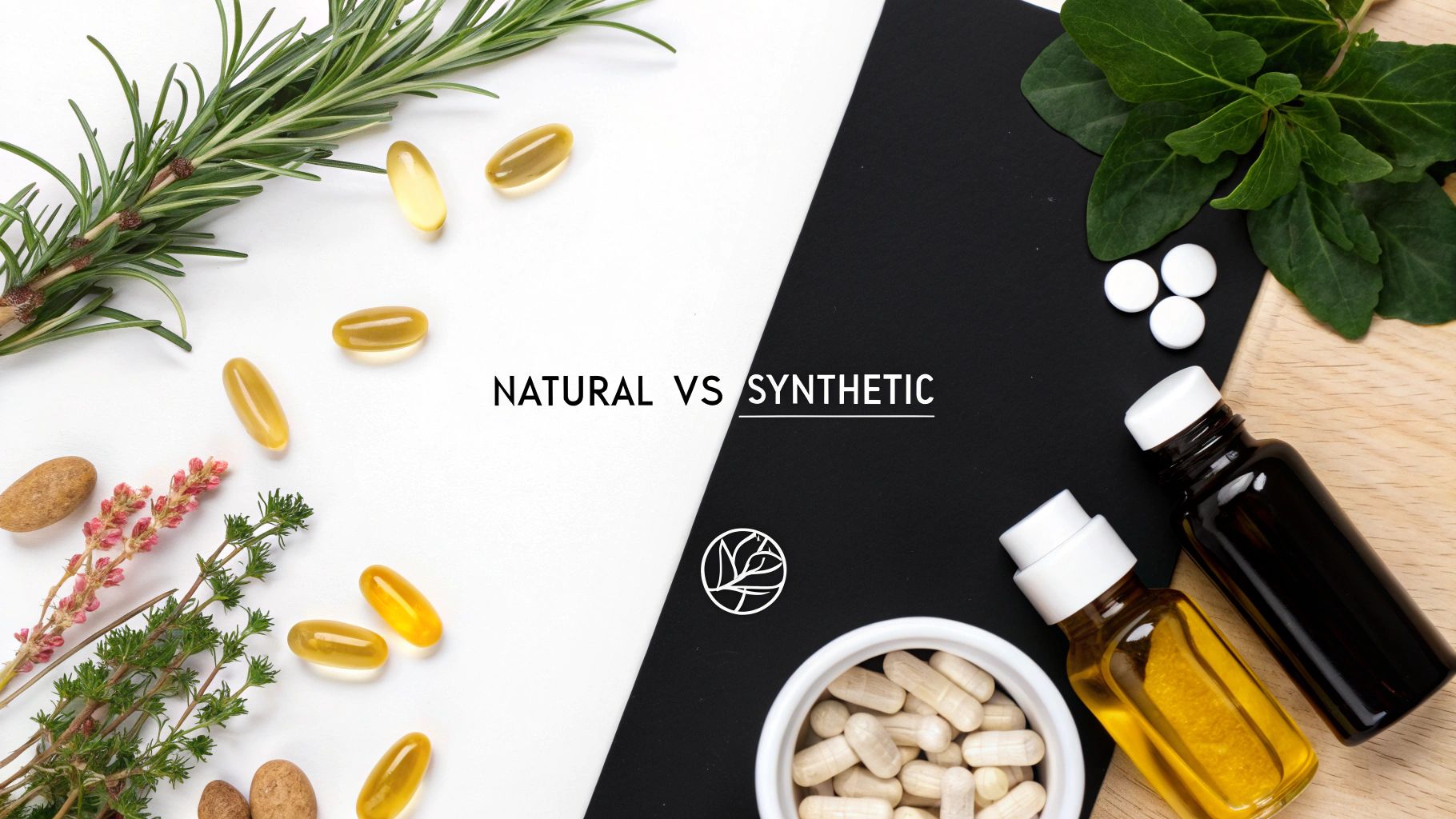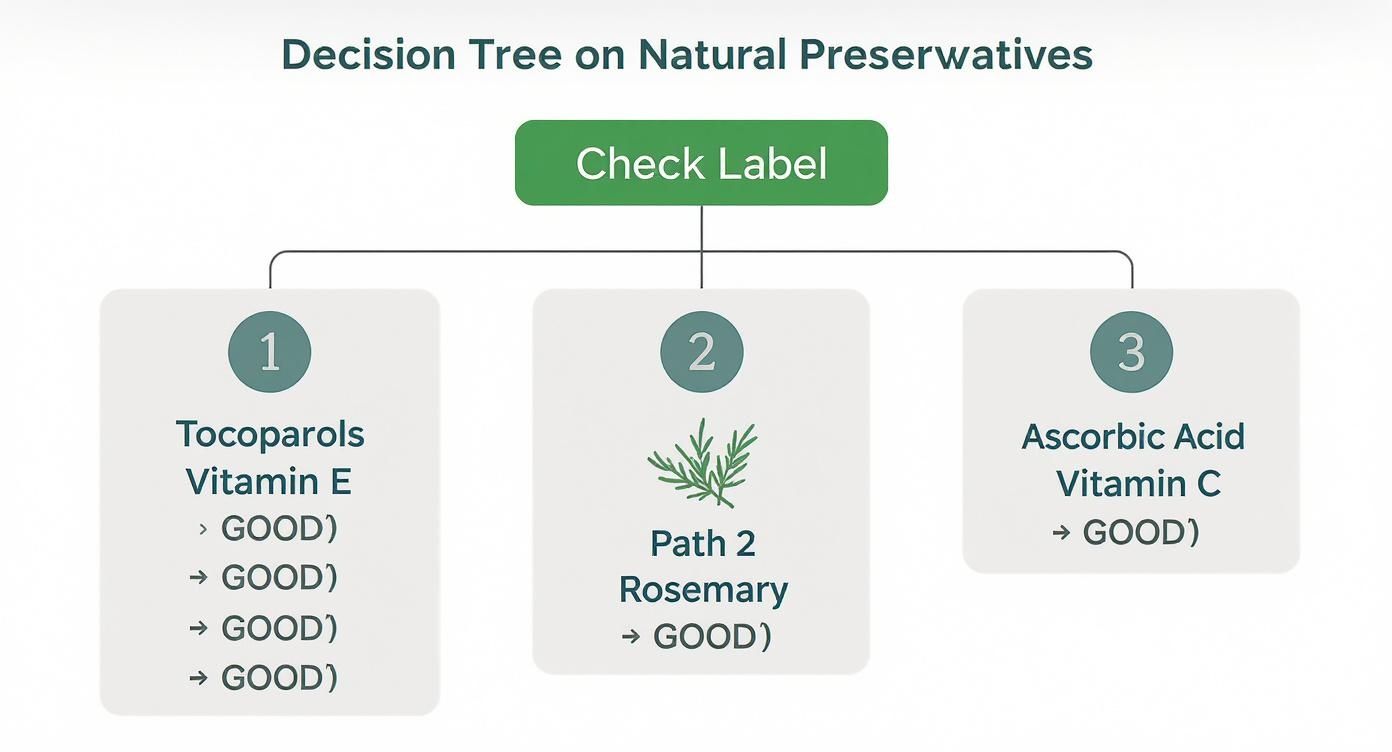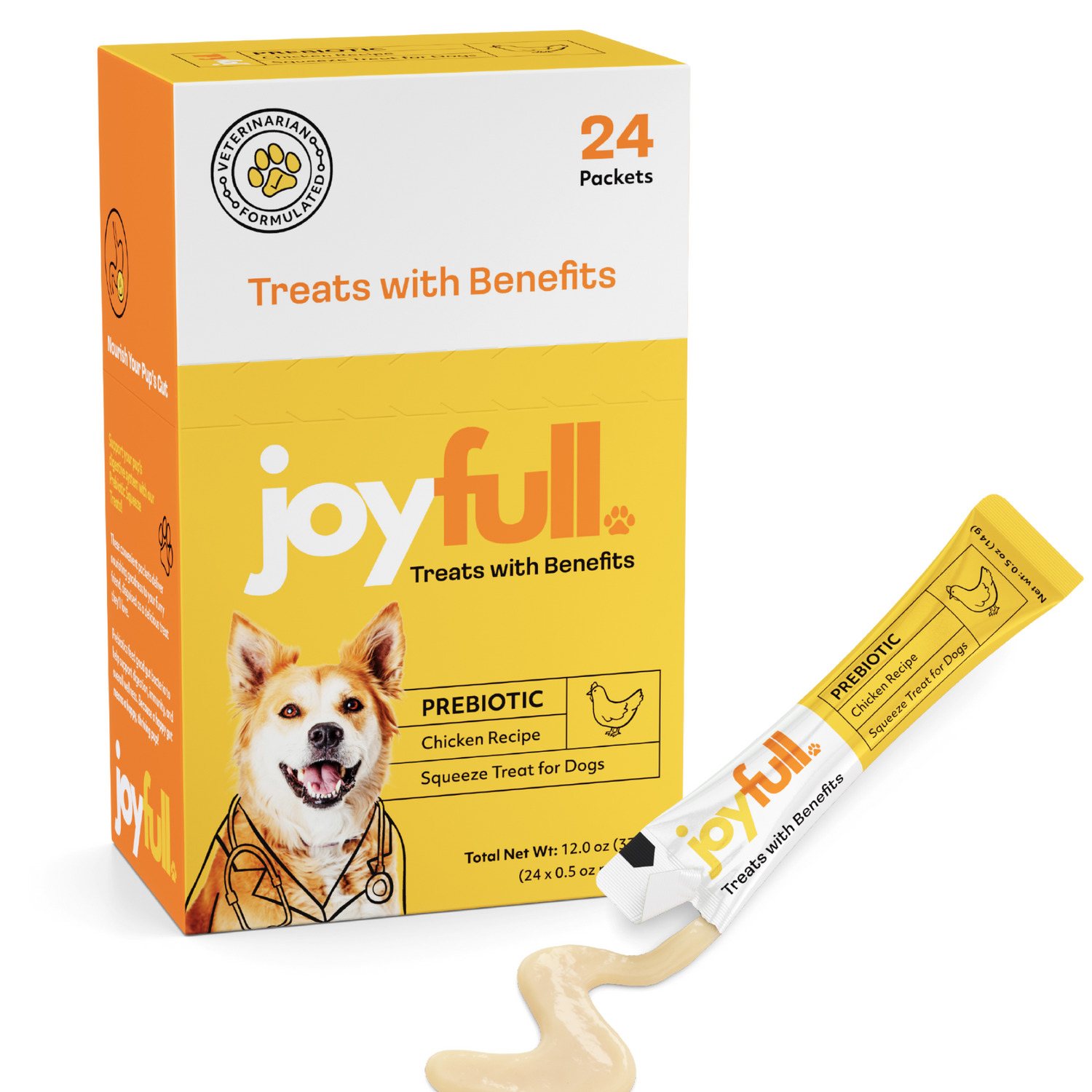
Natural Dog Food Preservatives Explained
When you see "natural preservatives" on a dog food label, it simply means the ingredients used to keep that food fresh and safe come from natural sources, like plants and vitamins. Instead of using artificial chemicals, these recipes rely on things like Vitamin E (often listed as mixed tocopherols) and rosemary extract to prevent spoilage and maintain nutritional quality.
Why Preservatives Are in Your Dog's Food

Ever wonder how a big bag of kibble can stay fresh in your pantry for weeks on end? That's the work of preservatives. They're not just filler ingredients; they're essential for keeping your dog's food safe to eat and nutritionally sound. They are the food's built-in defense system against going bad.
It’s a bit like comparing a fresh apple to a dried one. A fresh apple will start to brown and spoil in just a few days. The dried apple slices, however, last for ages because the moisture that bacteria love has been removed. Preservatives in dog food have a similar goal, but instead of drying out the food, they actively stop the processes that lead to spoilage.
The Role of Preservation in Pet Food Safety
At its core, a preservative's main job is to stop the growth of mold, yeast, and harmful bacteria. Without this protection, a bag of dog food could quickly become a breeding ground for contaminants that could make your dog sick. But that's not all they do. Preservatives are also critical for protecting the fats and oils from going rancid—a chemical process called oxidation.
When the fats in dog food oxidize, they don't just start to smell and taste bad. The process actually destroys vital nutrients, like essential fatty acids and important fat-soluble vitamins. What was once a balanced meal can become something far less nutritious and potentially even harmful.
Preservatives are not just additives; they are guardians of nutritional integrity. They ensure that the fats, vitamins, and minerals listed on the bag are the same ones your dog is actually consuming at mealtime.
It's no surprise that the demand for natural, safer options is growing. The natural pet food market is projected to hit an incredible USD 23,052.0 million by 2035, which shows just how much pet parents are focusing on ingredient quality. You can dive deeper into this trend in this detailed report. This shift makes understanding natural preservatives and proper food storage techniques more important than ever.
Unpacking Natural vs. Synthetic Preservatives

When you flip over a bag of dog food and scan the ingredients, the preservatives listed will fall into one of two main categories: natural or synthetic.
Think of it this way: you can keep food fresh with something found in nature, like a vitamin, or with a compound created in a lab. Both get the same job done—stopping the fats and oils in the food from going rancid, a process called oxidation.
Synthetic preservatives like butylated hydroxyanisole (BHA), butylated hydroxytoluene (BHT), and ethoxyquin are extremely effective. They’re great at what they do and give products an incredibly long shelf life. However, even though they're approved for use, many health-conscious pet owners are looking for cleaner, more recognizable ingredients.
This shift toward "clean" labels isn't just a small trend; it's a huge movement that's reshaping the pet food industry. The global market for these preservatives is expected to hit USD 534 million by 2030, largely because more people are demanding premium, natural options. If you're interested in the market data, you can explore the full report on pet food preservative trends.
The Natural Approach to Keeping Food Fresh
Instead of artificial chemicals, natural dog food preservatives tap into the power of antioxidants that already exist in nature. These are ingredients you might even find in your own kitchen or supplement cabinet. They essentially act as bodyguards for the delicate fats in dog food, protecting them from breaking down and spoiling.
You'll often see these on the label:
- Mixed Tocopherols: This is just a fancy, pet-safe name for Vitamin E.
- Rosemary Extract: A familiar herb that’s packed with antioxidant properties.
- Ascorbic Acid: Another name for Vitamin C, a well-known freshness protector.
These ingredients work by offering themselves up to oxygen first, preventing it from attacking the fats and oils in the kibble. This simple act of sacrifice keeps the food from turning rancid, which preserves both its flavor and its nutritional integrity.
To make the differences clearer, let's look at a side-by-side comparison.
Natural vs Synthetic Preservatives at a Glance
| Feature | Natural Preservatives | Synthetic Preservatives |
|---|---|---|
| Source | Derived from plants, vitamins, and minerals (e.g., rosemary, Vitamin E). | Chemically synthesized in a laboratory. |
| Common Examples | Mixed tocopherols, rosemary extract, ascorbic acid. | BHA, BHT, ethoxyquin. |
| Primary Function | Antioxidants that slow down fat oxidation. | Potent antioxidants that prevent spoilage. |
| Shelf Life | Provides a shorter, but sufficient, shelf life (typically around 12 months). | Extends shelf life significantly (often 18-24 months or more). |
| Pet Parent Perception | Highly favored for being "clean" and recognizable. | Often viewed with concern or skepticism by health-conscious owners. |
Ultimately, both types are approved for use and serve the critical purpose of keeping your dog's food safe to eat.
Choosing natural preservatives is about more than just avoiding certain chemicals; it's about actively selecting ingredients that are sourced from nature to maintain the quality and safety of your dog's food.
While dog foods with natural preservatives might have a slightly shorter shelf life, they offer peace of mind. For many owners, it’s a worthwhile trade-off that aligns with a more holistic approach to their dog’s health and well-being.
Common Natural Preservatives to Look For
Trying to decipher a dog food label can feel like a pop quiz in chemistry. But once you know what to look for, spotting the good stuff—the natural preservatives—is actually pretty simple. These ingredients are the unsung heroes working to keep your dog's food fresh, safe, and full of nutrients.
Think of them as nature's own freshness keepers. The most common ones you'll see on a label are either derived from vitamins or pulled directly from plants. Their names might sound technical, but their sources are completely down-to-earth.
Vitamin-Based Preservatives
One of the most common natural preservatives you'll find is mixed tocopherols. That’s just the scientific way of saying a blend of different forms of Vitamin E. It’s a fantastic antioxidant, which means it stops the fats and oils in the food from going rancid. It’s like an invisible shield protecting the food’s quality.
You’ll also frequently spot ascorbic acid, which is simply the technical term for Vitamin C. It often works as a team with mixed tocopherols, boosting their power to keep the food fresh without relying on artificial chemicals.
When you choose a food with these vitamin-based preservatives, you’re not just dodging synthetic additives. You’re also giving your dog extra nutrients that support their overall health.
Plant-Derived Guardians
Mother Nature has her own lineup of powerful preservatives, and you'll find them in many high-quality dog foods. Certain plant extracts are packed with antioxidant properties that are perfect for the job.
- Rosemary Extract: This is a heavyweight in the natural preservative world. It’s incredibly effective at preventing fat spoilage and even adds a subtle, pleasant aroma.
- Green Tea Extract: Loaded with beneficial compounds, green tea extract is another great option for protecting the food’s integrity.
- Spearmint Extract: You'll often see spearmint working alongside other natural preservatives, adding another layer to the antioxidant protection.
These kinds of ingredients are a hallmark of a well-crafted recipe. Gaining a better understanding of the best dog food ingredients is the first step toward making great choices for your dog.
So, next time you're in the pet food aisle, look for names like mixed tocopherols or rosemary extract. Seeing them on the label is a huge green flag. It tells you the brand is committed to keeping its food fresh and safe the natural way, so you can be confident you're bringing home a wholesome meal.
How to Read Dog Food Labels Like a Pro
Staring at a dog food label can feel like trying to decipher a foreign language. But don't worry, you don't need to be a pet nutritionist to figure it out. When you're hunting for natural preservatives, the secret is to look toward the end of the ingredient list.
Think of it this way: ingredients are listed by weight, from heaviest to lightest. The big players like meat and carbs are always up top. The smaller, but no less important, ingredients like vitamins, minerals, and preservatives usually hang out near the bottom. That's your target zone.
Finding the Good Stuff
Your goal is to scan that last section for the natural heroes we've been talking about. Look for names you recognize now, like mixed tocopherols (a form of Vitamin E), rosemary extract, or ascorbic acid (Vitamin C). Spotting these is a fantastic sign that the brand is committed to keeping the food fresh the natural way. It's a double-win, really—they preserve the food and add extra nutritional benefits.
On the flip side, you want to be wary of anything that sounds vague. For instance, if you see an ingredient like "animal fat" but it doesn't say how it's preserved (like "animal fat preserved with mixed tocopherols"), that's a bit of a red flag. That kind of ambiguity can sometimes be a way to avoid listing less desirable synthetic preservatives.
Becoming a confident label reader is a game-changer. If you want to dive deeper, our complete guide on how to read dog food labels can turn you into an expert.
This little decision tree is a great cheat sheet to use when you're in the pet food aisle.

As you can see, finding ingredients like tocopherols or rosemary extract is a clear signal that you’re looking at a product with quality, natural preservatives.
Honestly, it just takes a little practice. Before you know it, you'll be able to scan a label in seconds and feel confident that you're making the best possible choice for your furry family member.
The Health Benefits of Choosing Natural Options
When you choose dog food with natural preservatives, you're doing more than just sidestepping synthetic chemicals. You’re actively upgrading your pet’s diet.
Opting for ingredients like mixed tocopherols or rosemary extract means you're adding valuable nutrients to their bowl, not just keeping the kibble fresh.
These natural options often come with some great built-in perks. For one, they tend to be gentler on the digestive system, which can help sidestep the food sensitivities sometimes triggered by artificial additives. It’s a bit like choosing a whole apple over an artificially flavored candy—one is packed with pure nutrition, while the other can sometimes cause a bit of an upset.
More Than Just Preservation
Here's the best part: many natural preservatives are true multitaskers. They don't just stop food from spoiling; they contribute directly to your dog’s health.
- Vitamin E (Mixed Tocopherols): This isn't just a preservative; it's a powerful antioxidant that supports a strong immune system, healthy skin, and a shiny coat.
- Vitamin C (Ascorbic Acid): Famous for its immune-boosting power, this vitamin also helps protect your dog's cells from damage.
This double-duty action means every meal is an opportunity to enhance your dog’s diet, supporting their long-term health from the inside out.
By selecting foods with natural preservatives, you are investing in your dog's wellness. You're choosing ingredients that work in harmony with their body, promoting better digestion and providing bonus nutritional value.
This commonsense approach is clearly catching on. The U.S. market for organic and natural pet food hit a value of USD 8.1 billion in 2024 and is on track to more than double by 2033. This growth is fueled by pet parents who are paying closer attention to ingredient quality. You can see more data on this shift in the latest natural pet food trends on imarcgroup.com.
At the end of the day, picking a food with natural preservatives is a simple but meaningful choice you can make for the health and vitality of your best friend.
Got Questions? We've Got Answers
Even when you're on board with the benefits, a few questions might still be nagging you. Let's dig into some of the most common things pet parents wonder about when it comes to natural preservatives in their dog's food.
Are Natural Preservatives Really as Good as the Artificial Stuff?
For a food’s normal lifespan, absolutely. Natural preservatives, especially mixed tocopherols, are fantastic at their job—they stop fats from going rancid and keep the kibble fresh for a typical shelf life of about 12 months.
Now, it's true that synthetic options like BHA and BHT are a bit more heavy-duty, sometimes pushing that shelf life out to 18-24 months or even longer. But for the vast majority of us who buy a new bag of food every few weeks or months, the protection from natural preservatives is more than enough to keep it safe and tasty down to the very last scoop.
Could My Dog Have a Reaction to Natural Preservatives?
It's a fair question, but the answer is that it's highly unlikely. While any dog can have a sensitivity to just about any ingredient, a reaction to things like rosemary extract or mixed tocopherols is pretty rare. They're known for being gentle and easy on a dog's system.
If you’re seeing signs of a food sensitivity, the culprit is far more likely to be a major ingredient like a common protein (think chicken or beef) or a grain like corn or wheat.
A bag that screams "natural" on the front is a good starting point, but it's not a guarantee. The only real way to know what's inside is to flip it over and scan the complete ingredient list.
Taking a well-rounded view of your dog's health means looking beyond just their food bowl. It involves staying informed on all aspects of their care, from nutrition to routine vet visits. For instance, pet parents often have questions about things like how often dogs need rabies vaccines to ensure their companions stay protected. Arming yourself with this kind of knowledge empowers you to be the best advocate for your dog's total well-being.
Here at Joyfull, we're all about being upfront and honest. Our recipes rely on high-quality, natural preservatives because we believe a healthy life shouldn't be reserved just for people. Explore our commitment to clean ingredients.

